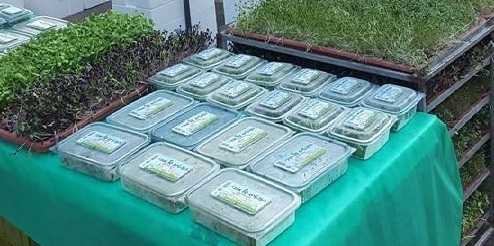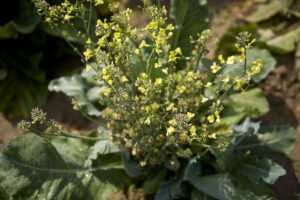The month of festive lights began with saturating, healing showers and some happy news: an invitation from Iza Pziza for a Chanuka visit, and the arrival of a new sprout grower to join Chubeza’s circle of associates – Udi from Moshav Achituv.
Here are the details:
Iza Pziza Invites YOU!
 Just like the Hanukah candles, we get a new young goat every day!
Just like the Hanukah candles, we get a new young goat every day!
Here, the holiday has already commenced, and the goat families are growing… Our Iza Pziza was so excited that she bore 5 sweet little kids – an all-time record…
We cordially invite one and all to come to visit with your families. All ages are welcome to enjoy an unforgettable experience: a Circassian cheese-making workshop, very easy to prepare at home, along with a tour of our pen, petting and feeding the goats, and of course, a chance to personally welcome our new baby goats.
At the end of the workshop (1.5 hours), we will spoil you with a taste of our dairy’s delectable cheeses and yogurts. Each family will receive their own cheese recipe and certificate of participation, including a special a discount on our dairy orders and cheese-making equipment.
You’re welcome to stay and hang out at the nice warm Visitor’s Center, before or after the workshop, and enjoy a meal of goat cheeses, breads, dips and vegetables, and coffee/tea or wine. We also have a cheese delicatessen and a beautiful boutique store where you can purchase great delicacies for your home: goat cheeses, jams, olive oil, honey, dips and more.
When are we open? Every day of Hanukah (and school vacation) between 8:30-16:30 (closed on Shabbat) When do the workshops take place? Every day of the Hanukah vacation, at 10:00, 12:00, 14:00 Advance Registration: Register in advance by phoning or 08-6102876 or 052-2589900 or e-mail [email protected]. Pay upon arrival. Fee: 36 NIS per participant. No charge for children under age 3. Cash or credit. How do we get there? Put in עיזה פזיזה in your WAZE app, or head out to Moshav Tal Shachar. Just before the gate to the moshav, turn left towards the Dor Alon gas station, and follow the signs to our parking lot. How do we contact you? 08-6102876, 052-2589900, [email protected], or via our website www.izapzizadairy.com. Please like us on Facebbok: עיזה פזיזה מחלבת עיזים
We look forward to seeing you! Happy Hanukah greetings to all! The Iza Pziza crew – Meshek Tzaban, Moshav Tal Shachar
_________________________
Welcome, New Sprouter! Introducing Udi, and his special message:
 Hi, I’m Udi from Moshav Achituv. Over the past four years I have been growing organic sprouts under the label “Udi’s Sprouts.” We started with one tray of broccoli sprouts, and have now grown to the point where we supply fresh sprouts to fine organic farms and health stores throughout the country. Among our products: kale sprouts, mustard sprouts, broccoli sprouts, alfalfa sprouts, sunflower, wheatgrass, sprout mix and more.
Hi, I’m Udi from Moshav Achituv. Over the past four years I have been growing organic sprouts under the label “Udi’s Sprouts.” We started with one tray of broccoli sprouts, and have now grown to the point where we supply fresh sprouts to fine organic farms and health stores throughout the country. Among our products: kale sprouts, mustard sprouts, broccoli sprouts, alfalfa sprouts, sunflower, wheatgrass, sprout mix and more.
Here’s to sowing and reaping every day! With great love, Udi N’vatim
Udi’s Sprouts are available in packages of 1/2 liter (10 NIS) or 1 1/4 liter (18 NIS). Check out the entire assortment in our order system.
_______________________________
No wallflower
In the past, I only remembered her at the end of winter, after she had been visiting in your boxes diligently, modestly, quietly. This year, I finally decided to treat her with the respect she deserves and make her the star of a two-part Newsletter to continue next week. Because there’s so much to say about her, and she’ll be with us for awhile, all through winter.
Ladies and gentlemen: may I present:
THE CAULIFLOWER
Her name indicates familial relations: the flower of cabbage (Caulis in Latin), and rightfully so. Apparently, cauliflower was developed from the wild cabbage during the Roman Empire somewhere in the Mediterranean Basin (Greece/Italy/Turkey–it is unclear exactly where). From there it traveled to European countries, the Middle East, India and China. When I say “developed,” I mean developed by human beings, almost like a modern agricultural start-up, only much, much slower. Some of the most incredible changes in the field of species development didn’t occur as part of a budgeted, constructed research, but rather due to the very simple act of collecting and saving seeds from the plants favored by the farmer and preferring them over seeds from lesser-loved plants. This simple act of propagating one plant and not another had a tremendous influence on the improvement and evolution of a given specie or crop. Long before man understood the genetics of plants, his actions caused slow, small changes in the cultivars that accumulated with time, yielding genuine results.
The cauliflower and broccoli owe their lives to the farmers (or perhaps the farmers’ wives and children who were growing bored with cabbage quiche) who developed a craving for the undeveloped flower buds of the cabbage. They chose the plants that produced large blossom heads, producing seeds from these plants which they then planted the next season. And this was how cauliflower and broccoli were born, both different variations of an embryonic florescence of cabbage. The proper name of the cauliflower is var. botrytis, meaning “cluster” (broccoli, developed in Italy, received the title var. italica).
In the case of cauliflower, like broccoli, we actually eat the immature flower curd composed of densely clustered flower buds and stalks that thickened and became meaty. As the cauliflower grows, this head is surrounded by a dense circle of leaves that close themselves and cover it, similar to cabbage. The inner leaves bend a bit inwardly, protecting the developing cauliflower and preventing sunrays from penetrating, thus blocking the production of chlorophyll and retaining its white color. This is why when we farmers select a variety of cauliflower, we give preference to choosing one whose leaves close well over the inflorescence. Sometimes, when the farmer notices that the leaves are not doing their job, he or she walks through the field and ties the outward leaves with a rubber band so that they cover the cauliflower and protect it from the sun. Unlike broccoli, which develops additional heads on its side after the main head is harvested, the cauliflower only produces one, in the center of the plant, and does not continue to yield after this single harvest. Usually the cauliflower is picked when it reaches its maximum size, still maintaining its density and solidity (or when we notice the leaves beginning to open, threatening cauliflower “sunburn”). If we leave it in the field, the inflorescence will begin opening and separating, preparing for the blossoming of tiny yellow flowers, like a great big bouquet.
When I wrote about the cauliflower a few years ago, I received an email from Eitan of Tel Aviv: “I beg to differ over one thing. I have been raising cauliflowers for two years in a row. I did not pull out last year’s plants, and sure enough, they bloomed this year as well. In addition, the cauliflower produced many branches that yielded a nice crop of cauliflowers. I pick the heads but do not pull out the plant.”
Eitan’s words reminded me that I did indeed read about the cauliflower’s ability to produce two years in a row if it is not uprooted, but because I was not experienced with this (as farmers, it is not recommended to leave vegetables for the next year because this usually reduces crop size), I asked Eitan for full details on the second-year cauliflowers. This was his response: “The cauliflower is smaller in the second year, but still tastes sweet. The advantage is that in the second year, a bunch of cauliflowers emerge. Branches extend from the bottom part of the plant, looking like cauliflower transplants from the nursery, and the inflorescence starts there. Since I have a small garden, the cauliflowers were watered over summer, but did not bloom, although I covered them with a 50% shade net. In any case, there was no evident change in the cauliflower over the summer. I recommend that whoever has enough space should leave the cauliflower and broccoli to grow a second year. These plants are bi-annuals. By the way, the broccoli, too, remained from last year, and it continues to supply me with very handsome “baby broccolis.”
So for the farmers among you, try this at home (in your garden). Keep the cauliflowers growing a second year, protect them in the summer from radiation and heat, and tell us how this works. Thank you, Eitan!
Like the rest of her Brassicaceaes family, the cauliflower consumes a great deal of nitrogen. For this reason, it’s important to grow cauliflowers in fertile soil, fortified with compost, and precede its planting with the growth of legumes or “green manure” that enrich the ground with nitrogen. Following a crop of cauliflower and other Brassicaceaes, we try to grow only cultivars that require less nitrogen and can deal well with the earth that must recover from the previous high level of nitrogen consumption. The gourd family (pumpkins) that grows in springtime and summertime, after the Brassicaceaes season, are a good example of a “crop rotation” after the Brassicaceaes.
Cauliflower grows in cool seasons. We used to plant it over two rounds, once in autumn (September- November) and then at the end of wintertime/beginning of springtime (February- April). But after some experimenting, we realized the cauliflower is happiest in our field during wintertime. The autumn and winter cauliflowers yielded beautiful plants, whereas the February harvests had a hard time growing, became too hard, was attacked by insects, got blotched with stains, and didn’t really thrive. On the other hand, we learned to bring up the planting to August, and over the past few years we have begun planting cauliflowers continuously from August to December. In August, we plant species that do well in the heat and from September we plant winter species.
Tune in next week for More About Cauliflower!
______________
Meanwhile, it’s time for some special greetings:
On Monday, December 5th, our Thai workers celebrated The King’s Birthday, which began in honor of the birthday of King Bhumibol Adulyadej, “Rama IX,” who died just two months ago. We wish all of our workers a great holiday!
And, for two members of the Chubeza family:
*Mazal tov to Muhamed on his 51st birthday! May you enjoy long, happy years to come, blessed with family, happiness, and fulfillment. Best wishes from us all!
*Mazal tov to our super-translator Aliza on her 21 ½ birthday (on each side). A Chubeza wish for a year of sunshine, gentle breezes, nourishment, growth, and beauty!
Wishing all of you a sunny, lovely week and a great winter to come!
Bat Ami, Alon, Dror, Yochai and the entire Chubeza team
_________________________________
WHAT’S IN THIS WEEK’S BOXES?
Monday: Coriander/parsley/dill, kale/Swiss chard, beets/turnips/fennel, sweet potatoes, cucumbers/Dutch cucumbers, cauliflower, arugula/lettuce/bok choy, daikon/baby radishes, tomatoes, carrots/potatoes. Small boxes only: Jerusalem artichokes/pumpkin.
Large box, in addition: Broccoli/cabbage, Thai lubia/peas/green bell peppers/eggplant, New Zealand spinach/winter spinach, celery/celeriac.
Wednesday: Pac choi/lettuce/mizuna, turnip/fennel/beets, cauliflower/kohlrabi, Swiss chard/kale, cucumbers/Dutch cucumbers, tomatoes, carrots/potatoes, sweet potatoes, parsley/arugula, radish/small radish/daikon. Small boxes only: Jerusalem artichokes/pumpkin.
Large box, in addition: Broccoli/cabbage, Thai lubia/peas/green onions, New Zealand spinach/winter spinach, celery/celeriac.
in the meantime, enjoying the winter showers and the sunny days that follow…
Alon, Bat Ami, Dror, Yochai and the Chubeza team




